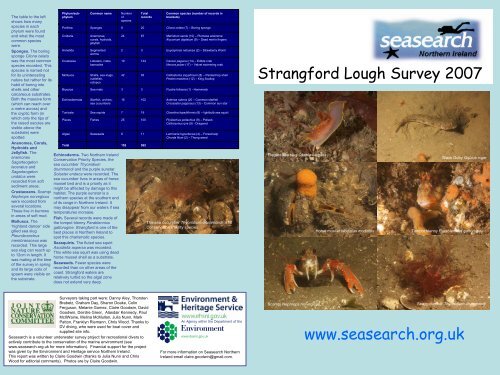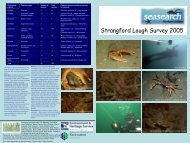Strangford Lough 2007 - Seasearch
Strangford Lough 2007 - Seasearch
Strangford Lough 2007 - Seasearch
Create successful ePaper yourself
Turn your PDF publications into a flip-book with our unique Google optimized e-Paper software.
The table to the left<br />
shows how many<br />
species in each<br />
phylum were found<br />
and what the most<br />
common species<br />
were.<br />
Sponges. The boring<br />
sponge Cliona celata<br />
was the most common<br />
species recorded. This<br />
species is named not<br />
for its uninteresting<br />
nature but rather for its<br />
habit of boring into<br />
shells and other<br />
calcareous substrates.<br />
Both the massive form<br />
(which can reach over<br />
a metre across) and<br />
the cryptic form (in<br />
which only the tips of<br />
the raised oscules are<br />
visible above the<br />
substrate) were<br />
spotted.<br />
Anenomes, Corals,<br />
Hydroids and<br />
Jellyfish. The<br />
anemones<br />
Sagarteogeton<br />
laceratus and<br />
Sagarteogeton<br />
undatus were<br />
recorded from soft<br />
sediment areas.<br />
Crustaceans. Scampi<br />
Nephrops norvegicus<br />
were recorded from<br />
several locations.<br />
These live in burrows<br />
in areas of soft mud.<br />
Molluscs. The<br />
‘highland dancer’ side<br />
gilled sea slug<br />
Pleurobranchus<br />
membranaceus was<br />
recorded. This large<br />
sea slug can reach up<br />
to 12cm in length. It<br />
was mating at the time<br />
of the survey in spring<br />
and its large coils of<br />
spawn were visible on<br />
the substrate.<br />
Phylum/subphylum<br />
Common name Number<br />
of<br />
species<br />
Porifera Sponges 8<br />
Cnidaria Anemones,<br />
corals, hydroids,<br />
jellyfish<br />
Annelida Segmented<br />
worms<br />
Crustacea Lobsters, crabs,<br />
barnacles<br />
Mollusca Shells, sea slugs,<br />
cuttlefish,<br />
octopus<br />
Total<br />
records<br />
Surveyors taking part were: Danny Aley, Thorsten<br />
Brabetz, Graham Day, Sharon Doake, Colin<br />
Ferguson, Melanie Gomez, Claire Goodwin, David<br />
Goodwin, Deirdre Greer, Alasdair Kennedy, Paul<br />
McIlWaine, Melina McMullan, Julia Nunn, Mark<br />
Patton, Franklyn Riemann, Chris Wood. Thanks to<br />
DV diving, who were used for boat cover and<br />
supplied site info.<br />
<strong>Seasearch</strong> is a volunteer underwater survey project for recreational divers to<br />
actively contribute to the conservation of the marine environment (see<br />
www.seasearch.org.uk for more information). Financial support for the project<br />
was given by the Environment and Heritage service Northern Ireland.<br />
This report was written by Claire Goodwin (thanks to Julia Nunn and Chris<br />
Wood for editorial comments). Photos are by Claire Goodwin.<br />
24<br />
2<br />
19<br />
42<br />
Common species (number of records in<br />
brackets)<br />
Bryozoa Sea mats 3<br />
3 Flustra foliacea (1) - Hornwrack<br />
Echinodermata Starfish, urchins,<br />
sea cucumbers<br />
16<br />
Tunicata Sea squirts 7<br />
19 Clavelina lepadiformis (8) – lightbulb sea squirt<br />
Pisces Fishes 25<br />
100 P{ollachius pollachius (9) – Pollack<br />
Callionymus lyra (9) - Dragonet<br />
Algae Seaweeds 6<br />
11 Laminaria hyperborea (4) – Forest kelp<br />
Chorda filum (2) – Thong weed<br />
Total 152 562<br />
Echinoderms. Two Northern Ireland<br />
Conservation Priority Species, the<br />
sea cucumber Thyonidium<br />
drummondi and the purple sunstar<br />
Solaster endeca were recorded. The<br />
sea cucumber lives in areas of horse<br />
mussel bed and is a priority as it<br />
might be affected by damage to this<br />
habitat. The purple sunstar is a<br />
northern species at the southern end<br />
of its range in Northern Ireland. It<br />
may disappear from our waters if sea<br />
temperatures increase.<br />
Fish. Several records were made of<br />
the tompot blenny Parablennius<br />
gattorugine. <strong>Strangford</strong> is one of the<br />
best places in Northern Ireland to<br />
spot this charismatic species.<br />
Seasquirts. The fluted sea squirt<br />
Ascidiella aspersa was recorded.<br />
This white sea squirt was using dead<br />
horse mussel shell as a substrate.<br />
Seaweeds. Fewer species were<br />
recorded than on other areas of the<br />
coast. <strong>Strangford</strong> waters are<br />
relatively turbid so the algal zone<br />
does not extend very deep.<br />
20 Cliona celata (7) – Boring sponge<br />
87 Metridium senile (10) – Plumose anemone<br />
Alcyonium digitatum (9) – Dead men’s fingers<br />
3 Eupolymnia nebulosa (2) – Strawberry Worm<br />
124 Cancer pagurus (14) – Edible crab<br />
Necora puber (17) – Velvet swimming crab<br />
93 Calliostoma zizyphinum (8) – Painted top shell<br />
Pecten maximus (12) – King Scallop<br />
102 Asterias rubens (20 – Common starfish<br />
Crossaster papposus (13) – Common sun star<br />
The sea cucumber Thyonidium drummondi, a NI<br />
Conservation Priority species.<br />
For more information on <strong>Seasearch</strong> Northern<br />
Ireland email claire.goodwin@gmail.com.<br />
<strong>Strangford</strong> <strong>Lough</strong> Survey <strong>2007</strong><br />
Elegant sea slug Okenia elegans<br />
Scampi Nephrops norvegicus<br />
www.seasearch.org.uk<br />
Black Goby Gobius niger<br />
Horse mussel Modiolus modiolus Tompot blenny Parablennius gattorugine<br />
Sea cucumber Thyonidium drummondi
The anemone<br />
Sagateogeton<br />
laceratus and the<br />
slender sea pen<br />
Virgularia<br />
mirabilis.<br />
<strong>Strangford</strong> <strong>Lough</strong> Survey<br />
Our first survey of <strong>Strangford</strong> <strong>Lough</strong> was in 2005 when we surveyed the horse mussel Modiolus modiolus beds and associated species.<br />
These large mussels are an important species in the <strong>Lough</strong>. They were once abundant and large areas of the <strong>Lough</strong> were covered in clumps<br />
of mussels, which formed a sort of living reef. These “biogenic reefs” are important as they provide a hard surface for other species to<br />
colonise in what would otherwise just be a flat muddy area. It appears that the reefs have been damaged in recent year by mobile fishing<br />
gear and there are few areas of this biogenic horse mussel reef left in good condition. One possible way of allowing the reefs to recover is to<br />
close some areas to all sources of disturbance. We were asked by the Environment and Heritage Service Northern Ireland to survey some<br />
proposed non-disturbance sites.<br />
Other sites in the <strong>Lough</strong> were also surveyed by independent divers. For some frequently dived areas such as the ‘Alastor’ and ‘Lees’ wrecks<br />
we now have several records over three years, these data help us to monitor any changes in the <strong>Lough</strong>.<br />
North of Jane’s Rock (Horse Mussel Survey)<br />
Muddy, gently sloping seabed with covering of up to 80% dead horse mussel Modiolus modiolus shell (7-17m<br />
surveyed). Some live horse mussel individuals were present, up to 10% cover in some areas of the site, but in<br />
other areas only one or two live individuals were seen. In the deeper areas of the site the seabed composition<br />
altered, there were occasional small bedrock outcrops and large boulders on sandy gravel.<br />
Abundant common starfish Asterias rubens were seen and occasional common urchins Echinus esculentus.<br />
In some areas the black brittlestar Ophicomina nigra was abundant. The side gilled slug Pleurobranchus<br />
membranaceus was sighted at 17m. Some plumose anemones Metridium senile were present on the rock<br />
outcrops.<br />
North of Long Sheila (Horse mussel survey)<br />
Three pairs of divers surveyed slightly different areas of this site. The seabed was a gently<br />
sloping mud slope (10.6-14.8m surveyed). Much dead horse mussel Modiolus modiolus shell<br />
was present, up to 95% cover in some areas of the site. There were also a few clumps of live<br />
individuals, but only one pair of divers recorded seeing these. There were some areas of dense<br />
Ophiothrix fragilis and Ophicomina nigra brittlestar bed. Much life was attached to the horse<br />
mussel shell including the common feather star Antedon bifida and the helter-skelter hydroid<br />
Hydrallmania falcata. Some very large common starfish Asterias rubens were present. The sea<br />
cucumber Thyone roscovita and the purple sunstar Solaster endeca were recorded, both of<br />
these are Northern Ireland Conservation Priority species.<br />
Ringhaddy Sound<br />
Gently sloping seabed, primarily mud, with signs of life present, 1.2-15.5m surveyed. The site was extremely<br />
sheltered with large number of crabs present. Many man-made objects were recorded ranging from large wheels etc.<br />
used as mooring weights, to small items of rubbish (broken bottles, dishes etc.). Local fishermen seem to use the site<br />
as a dumping ground for by-catch: large numbers of broken shells were present. Ringhaddy sound lies north to south.<br />
The dive was directly out from Ringhaddy pier in an easterly direction.<br />
The ‘Alastor’ wreck<br />
This a fairly intact, upright, wreck which lies in 20m in the middle of Ringhaddy Sound. It is a popular dive site and was<br />
surveyed several times in <strong>2007</strong>. The seabed around the wreck was a mixture of mud cobbles and pebbles. The wreckage<br />
was densely covered with tall and short animal turf including the common feather star Antedon bifida and sea squirts.<br />
Some crevice cucumbers were present under the gunnel at the stern. There was also much life on the seabed<br />
surrounding the wreck including many anemone hermit crabs Pagarus prideaux, shore crabs Carcinus maenas, Black<br />
goby Gobius niger, and clumps of edible mussels Mytiilus edulis. Many of the shore crabs were infected with parasitic<br />
barnacles. Much litter was present including netting, tyres, and glass and ceramic bottles. In July a record was made of<br />
the elegant nudibranch Okenia elegans. This is a fairly rare nudibranch with only a few Northern Irish records, mainly from<br />
the north and east coasts. This is the first time it has been recorded from <strong>Strangford</strong> <strong>Lough</strong>.<br />
Many species use the horse mussel shell as a substrate<br />
including the common feather star Antedon bifida.<br />
East of Brown Rock (Horse mussel survey)<br />
Dive on east side of Brown Rock in proposed nondisturbance<br />
zone. Gently sloping mud seabed (9.6-<br />
23.2m surveyed) with scampi Nephrops norvegicus<br />
burrows. Slender seapens, Virgularia mirabilis were<br />
common. In deep water these were all very short<br />
(



